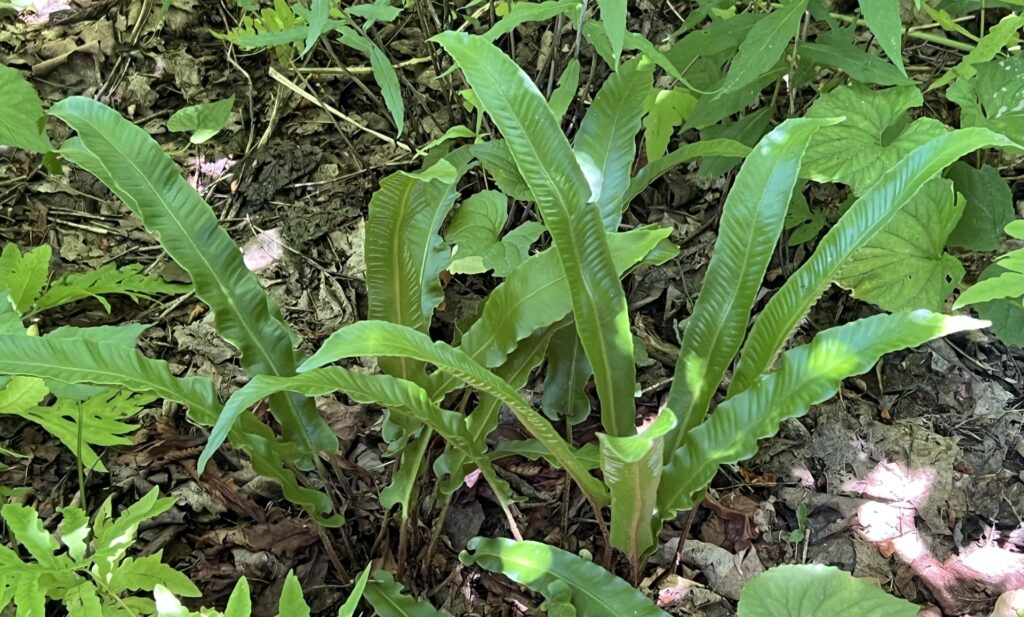
AUDIO TRANSCRIPTION – HART’S-TONGUE FERN
Spencer Buley, Reporter: Central New York has been home for the Hart’s-tongue fern since 1807. Stewardship Biologist Mike Serviss says threats to the fern’s existence persist with extreme weather in the Northeast.
Mike Serviss, Environmental Stewardship Biologist: Extremely wet springs, which is sort of what’s being forecasted under different climate change models can actually have a negative effect on the ferns, but also periods of drought in the summers are probably one of the main impacts to the ferns. That is also something that climate models predict.
Buley: Serviss and New York State Parks use data from the Fifth National Climate Assessment to inform their protective efforts. But Serviss says the fern itself serves as an informer.
Serviss: I’ve heard the Hart’s-tongue fern referred to as something like a canary in a coal mine, where if you see declines in that population, than you’re likely to see declines in other quote-on-quote stable species.
Buley: Clark Reservation hosts invasive species removal and citizen science events, with the next one on August 13th. Spencer Buley, N-C-C News.
SYRACUSE, N.Y. (NCC News) — New York State Parks (NYS Parks) cites Central New York’s hart’s-tongue fern as one of the rarest and most endangered ferns in the United States.
Deemed the “crown jewel” of Clark Reservation State Park by their welcome center, the hart’s-tongue fern is an indicator species that can serve as a tool used for judging ecosystem health and climate patterns. Mike Serviss, an Environmental Stewardship Biologist for NYS Parks, says that although population numbers have held steady recently, predictions forecasting even small changes in the Northeast climate could pose challenges to the fern’s survival in the future.
“Extremely wet springs, which is sort of what’s being forecast under different climate change models, can actually have a negative effect on the ferns,” he said. “But also, periods of drought in the summers are probably one of the main impacts to the ferns. That is also something that climate models predict as it gets warmer here in the summer.”
Researchers like Serviss primarily consult mapping data from the Fifth National Climate Assessment (NCA5), but they use the status of species like the hart’s-tongue fern to aid their environmental studies.
“The hart’s-tongue fern is what we consider a climatically sensitive species,” Serviss said. “And I’ve heard the Hart’s-tongue fern referred to as something like a canary in a coal mine, where if you see declines in that population, than you’re likely to see declines in other quote-on-quote stable species.”
According to NYS Parks, the fern was first discovered in 1807 just outside of Syracuse. The organization says quarrying, urban expansion, and illegal collection throughout the 20th century were the initial causes of massive declines in the fern’s population. In the last two decades, however, invasive species like swallow-wort have posed a larger threat.
“Other things that we do is invasive species management,” Serviss said. “So, we go into the habitats and the surrounding areas and remove any invasive species that are growing in there.”
Populations currently reside in ravines and plunge basins. NYS Parks states that 94% of all hart’s-tongue ferns in New York are concentrated in the Clark Reservation and Chittenango Falls State Parks. Serviss believes that as inhabitants of its home, Central New Yorkers have a responsibility to help the fern thrive.
“Because it’s a rare species, and because of what humans have done that’s caused it to decline and become a threatened species, I think it’s more of a, we have a responsibility to keep this species on the landscape because it’s been here so much longer than we have,” he said. “Despite what’s been done in the past, we can do something about it now.”
As they continue their education and outreach phase, NYS Parks offers invasive species removal events and citizen science events to the public around Chittenango Falls and Clark Reservation State Parks.
